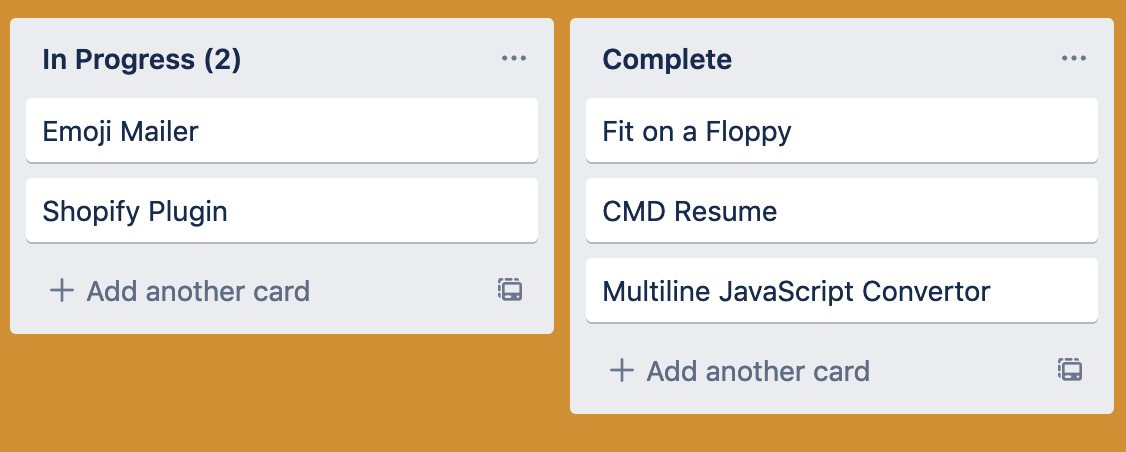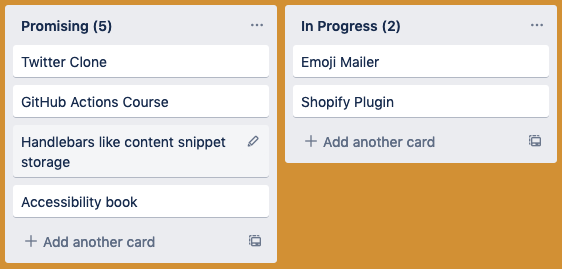Like most of us, I have my fair share of ideas that I want to pursue. For many years I had many books, courses, projects, and other endeavors that I wanted to pursue but never really got them done. Recently, while talking to a friend about a few of my recent projects that I finished or came very close to finishing, he mentioned that he has too many ongoing projects to finish anything. This really resonated with me as I had once been the same, but over the last few years I have slowly improved. So I got inspired to write this post about how I learned to finish projects.
I struggled a lot with getting things done. I would have too many projects ongoing at the same time, all with differing levels of completion and progress. Over the course of many iterations, I managed to come up with the following process.
1. Write down your project ideas
Grab a piece of paper or a blank page in your notebook, a cup of coffee (or your beverage of choice), and your pen or pencil. The next step is to write down any projects that you are working on or ideas that you are thinking of. No project is too small, no project is too unreasonable. Put everything on the page. I find this helpful for getting the vague cloud of ideas out of my head.
2. Transfer to a Kanban board
From here, I like to take those projects and put them onto a Kanban Board. My go-to service is Trello. I sort them into different columns representing their state, as below:
- Concept - just an idea at this stage
- Promising - an idea that I would like to work on sometime in the future
- In Progress - projects that are in progress
- Complete - the idea has been executed to a point where it is considered done
- Rejected - the idea has been rejected as not feasible, lost interest, etc.
I find this helps me get a view of where my ideas are, as well as providing a central place where they sit, so I never lose an idea.
3. Define
To me, this is the hardest step. Each idea needs to be defined. The goal of the idea is to execute on it, but what is it exactly? I like to set SMART Goals to help define what the end looks like. If a project’s goal is too open-ended, it is easy to just keep putting along and never really feel like you finish anything. This list of goals can be as long as you want, but please temper the goals based on whether you want them or think they will be useful. I find these goals often help with the project management aspect of setting up tasks.
4. Prioritize
Now that you have everything down on your kanban board, it is time to prioritize. Within each column, prioritize with the more important/urgent tasks towards the top. I’ve found this helps with figuring out what to do first.
5. Constrain
Those familiar with Kanban will be familiar with WIP Limits (Work in Progress limits), where a column has a limit on how many items can be in it. For my board, I use a limit of 2 on In Progress and 5 on Promising, which I have found to work for me. If you have too many tasks in these columns, move them to the previous columns. I would warn against having too liberal of a limit on In Progress, it is very important to limit the number of concurrent tasks.
I have found this to be the most important step, granted it takes a lot of self-control. For me, 2 ongoing tasks is enough to keep me focused while providing enough flexibility to do something else if I get bored.
6. Get working
This is the fun part! Well, depending on how you view it. Grind towards the goals.
7. Fall off the wagon
This is going to happen, you are going to fall off the wagon. It happens to me once in a while; don’t worry about it. Maybe your prioritization is wrong. All I can really say is to re-evaluate your ideas’ prioritization and the ideas in the In Progress column.
8. Finish
Once I move an idea into Complete I like to have a ceremony. For me it usually ends with a blog post (for example CMD Resume, Fit on a Floppy, Multiline JavaScript Converter, Commit Comp) and a nice meal. Choose another task and go back to Step 6!
?. Clean up
Once every few weeks, I like to do a cleanup on the board: adding more ideas, rejecting ideas that I’ve changed my mind on, moving finished ideas to complete, moving items to in progress, reprioritizing, etc. A Kanban board is pointless if it isn’t up to date.
I hope you are able to find some use in my process. Like I said, it has been an evolving process which I’ve molded for my purpose, but your mileage may vary and customization is required.
Got any comments or feedback? Feel free to go over to the Hacker News Discussion and let me know your thoughts!

